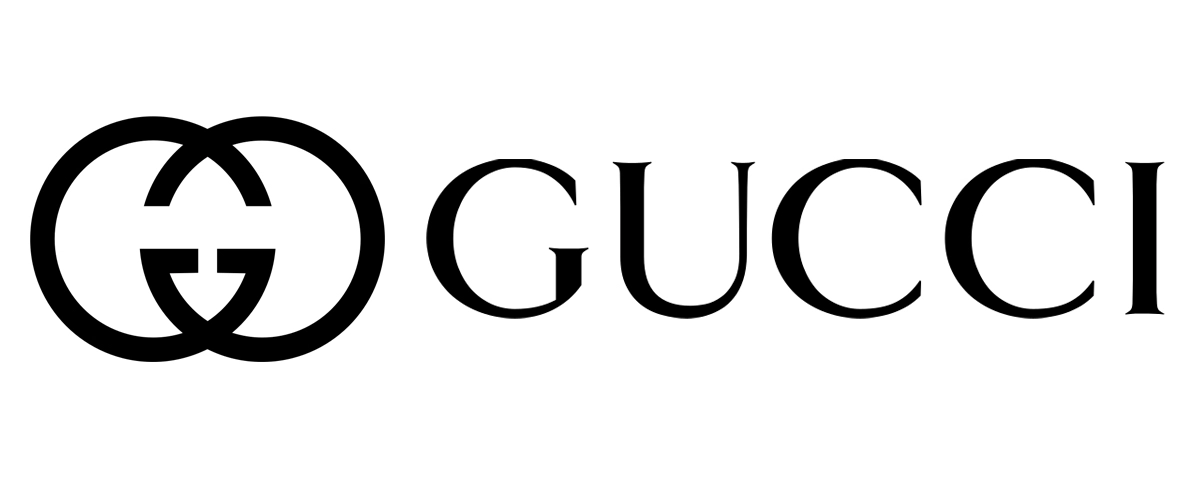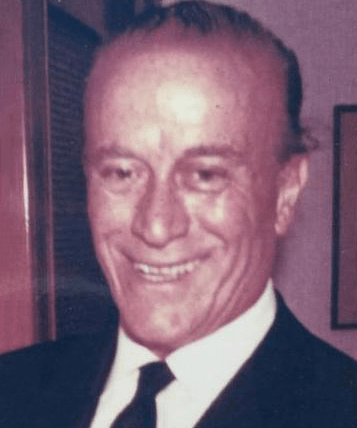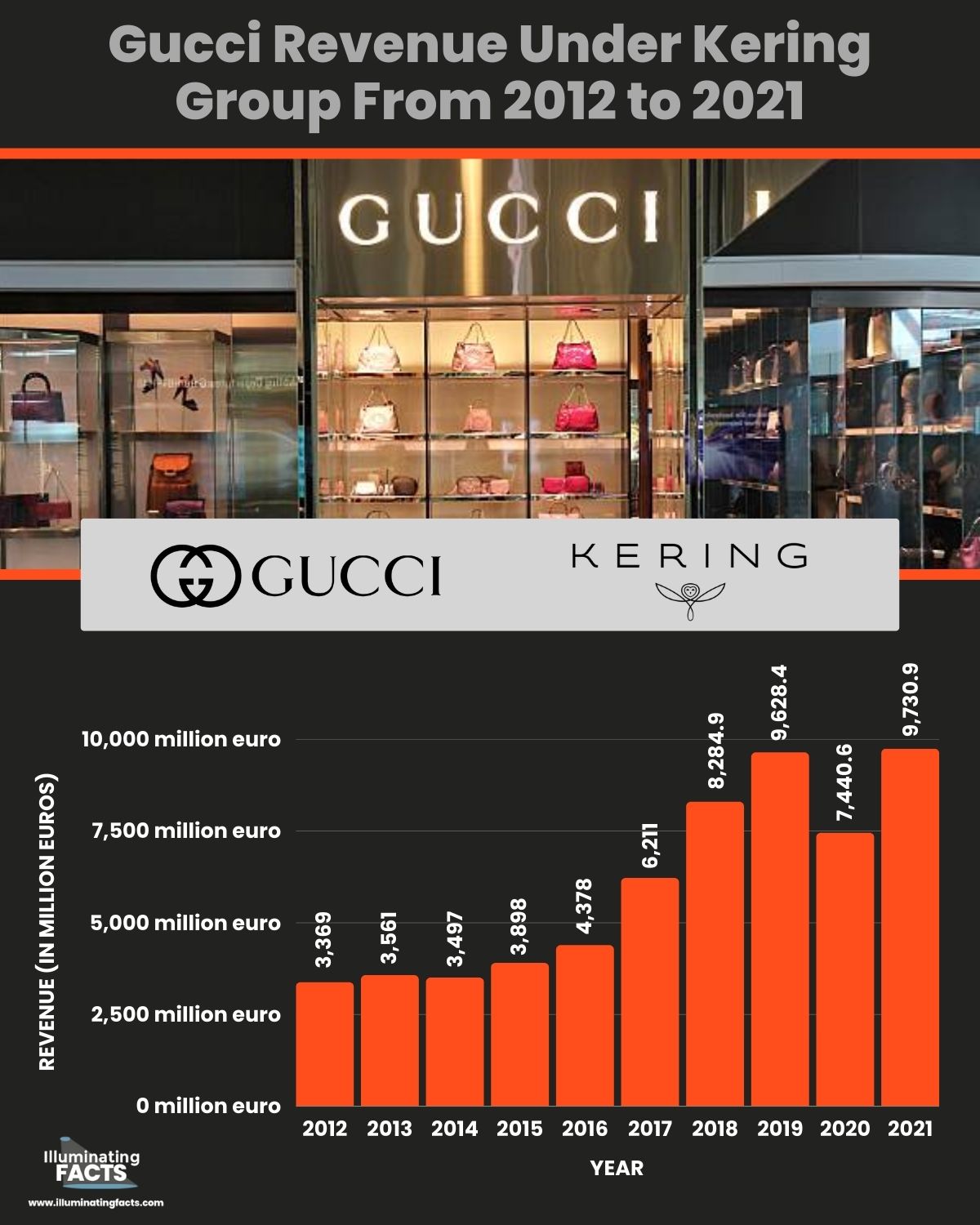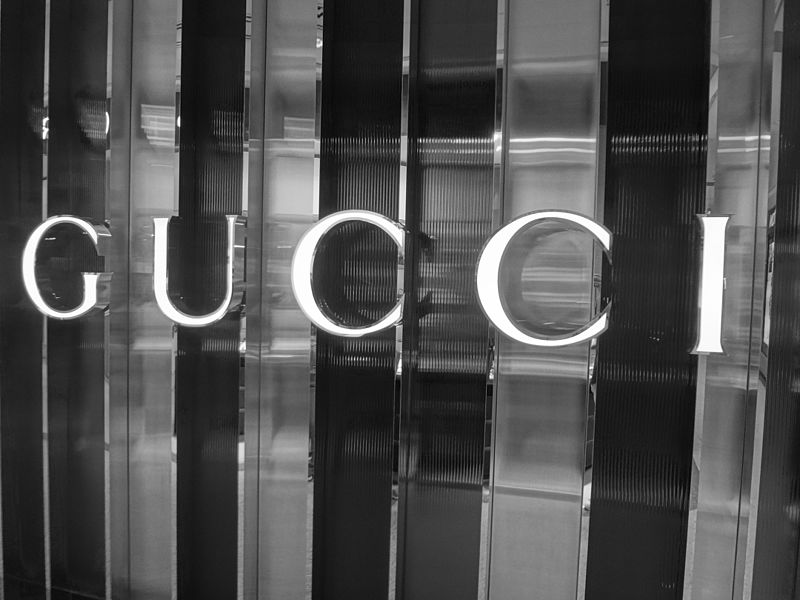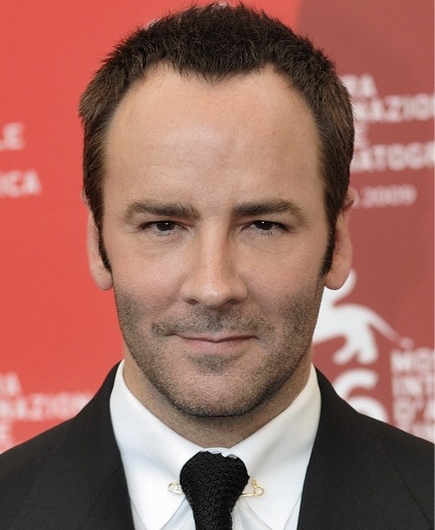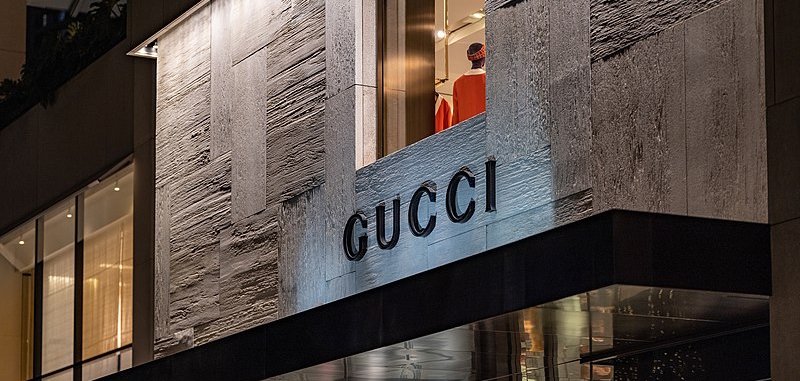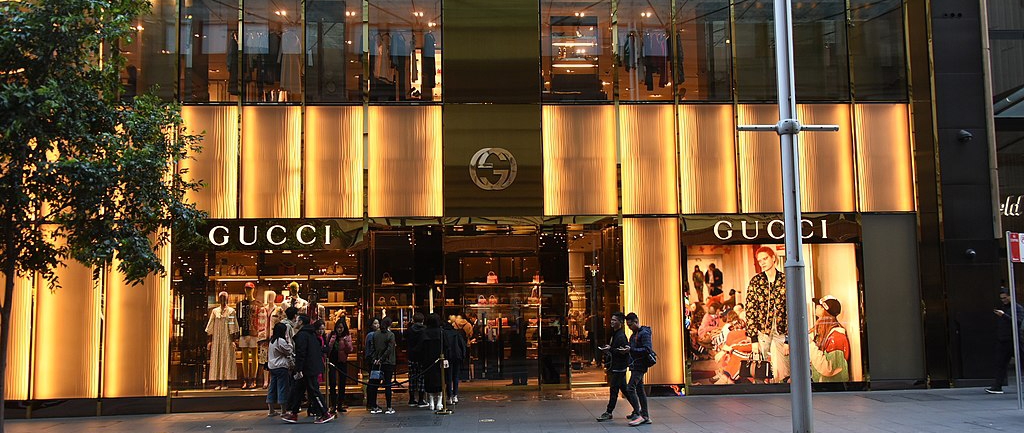Table of Contents
With the ongoing popularity of the fast-fashion industry, one brand remains steadfast in maintaining its life-long mission of being the worldwide leading fashion brand in the luxury market–Gucci. [1]
From teenagers who strive to one day wear one of its luxurious pieces to Wall Street executives who spend thousands of dollars on Gucci-labeled items and even superstars who have access to an exclusive level of luxury, Gucci is an in-demand luxury brand.
Several brands share the same level of X-factor that renders them synonymous with luxury across the board. Gucci, being one, is a part of that elite group of brands, including Hermés, Louis Vuitton, and Chanel. They not only boast billions in sales but also demand and receive worldwide respect and recognition.
However, the Gucci family, who had built the brand from the ground up, nearly destroyed it after a century. Despite their seemingly perfect rags-to-riches story, the very members of the family caused the House of Gucci to crash miserably. While many of the mistakes were attributable to classic family firm spats rooted in greed and jealousy, another major reason for the brand’s gradual decline was misplaced, short-term strategies that backfired badly. Continue reading to learn more about the rise and fall of the House of Gucci.
What Is the House of Gucci?
Gucci is among the world’s most influential and renowned luxury brands, a genuine global reference for accessories and fashion, and a model for a modern, innovative business.
The House of Gucci was founded by Guccio Gucci in Florence, Italy, in 1921. It is renowned for contemporary and eclectic creations that illustrate the highest form of Italian craftsmanship and are unrivaled in attention to detail, quality, and imaginative design.
Becoming a worldwide-known brand and a symbol of the Italian Dolce Vita (which means “the good life” or “the sweet life”), Gucci initially flourished under Aldo Gucci’s (son of Guccio) management. However, the Gucci family was completely removed from the company by 1993, following the family feuds in the 80s.
Following the many Gucci family battles, the brand was relaunched with provocative “Porno Chic” fashion show props, such as a G-string, silver handcuffs, and provocative ad campaigns like the G logo shaved on pubic hair. Gucci was then purchased in 1999 by Pinault Printemps Redoute, the French conglomerate that later became Kering. Gucci grew into an iconic ‘geek-chic’ brand in the 2010s. [2]
Today, Gucci is attempting to redefine luxury for the twenty-first century, an effort spearheaded since 2015 by Alessandro Michele, the brand’s Creative Director, and company President Marco Bizzarri.
Gucci Revenue Under Kering Group From 2012 to 2021 [4]
| Year | Revenue (in million euros) |
| 2012 | 3,369 |
| 2013 | 3,561 |
| 2014 | 3,497 |
| 2015 | 3,898 |
| 2016 | 4,378 |
| 2017 | 6,211 |
| 2018 | 8,284.9 |
| 2019 | 9,628.4 |
| 2020 | 7,440.6 |
| 2021 | 9,730.9 |
The Foundation and Beginnings of the House of Gucci
As the son of craftsman, Guccio Gucci inherited his parent’s passion for craftsmanship. [3] Born and raised in Florence, Italy, the then 16 years old Guccio needed to move to London, where he worked as a porter at the upscale Savoy Hotel. His job did not just allow him to mingle with members of the elite society; it also ignited his love for crafts making because he was fascinated by the trappings of the rich. [4] When Guccio went back to Florence in 1906, he founded the first ever House of Guccio but only as a saddlery shop where he sold saddles and bags with the intent to monetize his craftsmanship. [5]
In 1921, as consumers of the brand graduated from horse-led carriages to horse-less transportation, Gucci also shifted from selling horse-riding supplies and apparel to producing luxury goods, marking the initial phases of the modern incarnation of the company. [3] [4] It was also in the 1920s when the second generation of the Gucci family, Aldo and Vasco, and the adoptive son, Ugo, participated in the family business. Rodolfo, the youngest of the siblings, worked as an actor (known for his stage name Maurizio d’Ancora) and only joined after a few years. [4] Their participation in the company contributed to its continuous growth.
As they continuously worked on the establishment of their company’s reputation, Gucci hit a snag in 1935 after the League of Nations imposed sanctions due to Italy’s actions towards another country. This international dispute affected the country’s economy to the point wherein even leather was scarce. [6] The company looked for alternative materials to continue manufacturing its products to address this concern. The luxury goods produced using specially woven hemp were the first to have used the Gucci Diamante, the first signature print of the brand. [7]
Gucci: The Brothers’ Entry to the Business World
The company’s resilience amidst economic adversities allowed it to continue flourishing during the following years. In 1939, the three brothers Aldo, Vasco, and Rodolfo helped expand the company’s reach when they opened another store in Rome’s Via Condotti. [4] [8] Via Condotti was known, even until now, as Rome’s most fashionable street adorned with different luxury brands’ stores. [9]
The Second World War, which lasted from 1939 to 1945, affected all aspects of living. The company’s material resources for production were hard to come by. However, it did not stop Gucci from thriving. They made use of different raw materials as a substitute for what they were initially using. Instead of leather, Gucci’s artisans used bamboo and pigskin. The Japanese-treated bamboo replaced the typical leather bag handle. On the other hand, pigskin was used as a substitute for cow leather. These unusual creations and material experiments became two of the brand’s signature designs. [4]
Six years after the end of World War II, Guccio’s son Rodolfo led the opening of the first-ever Gucci store in Milan, where they also made the green-red-green web the hallmark of the company. [7]
Gucci: The Start of World Domination
As Gucci continued to gain success in Italy, it decided to risk its fate abroad. In 1953, Aldo, in an attempt to expand the business, flew to New York, USA, to open its first-ever boutique there. However, if triumph filled the atmosphere inside the Gucci company, it did not feel the same among Gucci family members. At age 72, the then-current head and founder of the House of Gucci died.
At the time of Guccio’s death, issues began to arise. The first of which was when the company was only divided among his male children, completely leaving out Grimalda, his only daughter. Despite this, the family business had to continue. While Aldo took over the operations in the United States, Vasco handled the Florentine business, and Rodolfo handled things from Milan.
During the same year, the Gucci store in New York became a huge success as high-profile personalities such as Elizabeth Taylor, Jackie Kennedy, and Grace Kelly developed a huge interest in the company’s luxury goods. [8] Also, this year marked the creation of the iconic Gucci loafer with a metal bit utilized to control a horse. Men’s loafers were among the most well-known earlier products that used the horsebit.
In the years that followed, Gucci was taking over the world. In 1961, Gucci stores opened in London and Palm Beach, Tokyo in 1972, and Hong Kong in 1974. [7]
The brand went beyond being just a clothing store selling unique and trendsetting luxury pieces and among the elites it became a status symbol. However, despite its success over the years, Gucci still experienced a bad fall caused by the very people who helped build its foundation.
The Fall of the Gucci Empire
Gucci was in turmoil due to an intra-family feud. Following the death of Vasco Gucci in 1974, Rodolfo and Aldo equally divided the business between themselves. Aldo’s sons felt that Rodolfo, their uncle, was not contributing to the company’s growth. Aldo then established a perfume company as a brand subsidiary, with himself and his sons owning 80% of the shares. But the family’s problems only got worse from there.
Paolo, son of Aldo and Gucci’s vice president, rebelled after his suggestion of creating his fashion line was rejected by his father and uncle. He went on with his idea and rejected what his older men had told him to do. Aldo, enraged, took his son to court and intimidated suppliers into not doing business with him.
After being fired from the company in 1980, an outraged Paolo filed a US$ 13.3 million lawsuit two years after, accusing his father, Rodolfo, his brothers Roberto and Giorgio, and his cousin Maurizio of assault during a meeting of the board.
Gucci: The Dwindling State of the Company and the Family
The following year, Rodolfo, the former one-time actor, died, leaving 40% of the company’s shares to his son, Maurizio, who automatically became the main shareholder of the business. [4] However, after a year, a C-suite shuffle was conducted, which named Aldo as the chairman of the board emeritus and Maurizio as the chairman of Gucci Shops Inc., wherein he managed the Gucci stores located in the USA. Aldo’s sons were named vice chairmen, and Domenico de Sole, not a family member, was identified as the company president.
In 1985, not long after Maurizio had taken his seat as one of the chairpersons in the company, he was questioned and sued by his uncle, Aldo, and cousins Roberto and Giorgio for arranging a forgery of his father’s signature on the stock certificates that formally transferred Rodolfo’s shares to him. This is said to have been done for him to gain control over the company and avoid paying his inheritance taxes. [4] Maurizio himself angrily denied this said allegation. News about the incident made rounds all over the world, which the Italian Court prompted as they sequestered the shares of Maurizio, current chairman of Gucci Shops Inc., [12]
The allegations against Maurizio, turned out to be true; the signature was deemed questionable by the law. Therefore, a decision regarding his attempted tax fraud case was released in 1988, wherein he only received a one-year suspended sentence and needed to post bail for $750. [13] Two years earlier this event, Aldo also pleaded guilty to the tax evasion case filed by his son, Paolo, leading to his imprisonment for a year. [11]
InvestCorp, a leading and global manager of alternative investments for private and institutional clients, first entered the scene in 1988, when it was invited by Maurizio to buy the sales of his relatives in order for him to gain true control of the company. [14] Aldo was the last one to give in until a year later, in 1989, when he finally decided to sell his portion of the shares. This act made InvestCorp the manager of 50% of the total shares, leaving the remaining to Roberto and Giorgio with 2% and Maurizio with 48%. [4] [15] Although Aldo remained as Gucci’s consultant, selling his shares ended his 65-year-long service to the legacy that his father had left.
In the same year, Maurizio gained the chairmanship of the business for the second time. His vice chairman was a representative of InvestCorp. He also sought the help of Dawn Mello, in charge of the revitalization of the luxury brand Bergdorf Goodman, as his new creative director. [16]
Following these events, Aldo died in 1990 in Rome, Italy, after suffering from prostate cancer. It was also in 1990 when Tom Ford first set foot in the company after he was hired by Mello to oversee the womenswear line for the same year. [4]
A couple of years after InvestCorp’s entered the company, Gucci America Inc. had lost more than $30 million, not including debts of above $100 million. [17] Internally, the fashion empire was in complete disarray. The House of Gucci was in shambles. Sales plummeted rapidly, and debts started to mount.
Gucci: The End of an Era
To pressure Maurizio to sell the remaining 50% of his stake to the Bahrain group, InvestCorp remarked that additional funds could only be accessed if Maurizio left the company. The Italian businessman fought back with countersuits, but in September 1993, he caved and sold the remaining interest to the investor group.
This transaction made it the first occasion that the firm’s control was not in the hands of the Gucci family. The family’s problems, however, did not end with the company being sold.
After the end of the Gucci Family’s involvement with the company, there were plans of reviving Gucci to its glory days. Therefore, in the following years, various clothing collections were released. In 1995, Tom Ford continued to impress the public with his skills as he clothed models with high-quality textiles such as shimmering satin, plush velvet, and patent leather. [4]
Death of Maurizio Gucci
On March 27th, 1995, Maurizio, 46, was fatally shot in front of his Milan office on March 27, 1995. [11] No one knew who shot Maurizio for the next two years, not until the Italian police received information about the involvement of Maurizio’s wife, Patrizia Reggiani.
Patrizia Reggiani, also known as the “Elizabeth Taylor of luxury labels” during the 1980s, was a wealthy Milanese woman Maurizio wedded against his father’s wishes in 1972. [8] As soon as she was married into the family and officially became a member of the House of Gucci, she served as a key advisor for the empire.
However, several years later, when Maurizio failed to bring the kind of leadership the company needed, Reggiani was filled with rage. Adding fuel to the fire was when he left for what was believed as a business trip and never returned, as well as his filing for divorce in 1994, which did not just simply mean an end to their relationship but also an end to her being a Gucci. [9]
Three years after the death of her now ex-husband, Reggiani was convicted of premeditated murder causing her to spend 29 years in prison. She hired a hitman to kill Maurizio. Despite her denial of the allegations thrown at her during her trial, “Black Widow,” as she was called back then, started to acknowledge her role in his death when she was released in 2016. [18]
The Fashion Empire’s Comeback from the Brink of Bankruptcy
Gucci: Tom Ford’s Role in the Revival of the Company
Gucci began its fightback, free of its feuding founder family, inheriting the debris of a cheapened brand and loose licensing. In 1992, Tom Ford became the company’s design director and handled several fashion collections including ready-to-wear and fragrances. Two years later he took over the position of creative director after Mello returned to Bergdorf Goodman. During his tenure he helped to turn around the company’s future. He transformed the general public’s mindset, who used to think of Gucci products as “has-been” into a “must-have.” [19]
In just over a year, Ford revitalized Gucci by introducing several new fashion ideas, such as velvet trousers, stylish dresses, sleek suits, and a whole new variety of boots and bags. Gucci profits soared to an astounding $83 million with revenues worth $500 million. His presence and contributions prevented the total downfall of one of the world’s leading luxury brands.
The same credit given to Tom Ford was also given to Domenico De Sole, who served as the CEO in the same year. De Sole was a former corporate attorney who did tax work for Rodolfo Gucci, who in turn paved the way for him to be the current head of Gucci in America during that time. His initial focus was to limit sales to wholly-owned Gucci stores, where the opulent surroundings added value to the products.
With Ford as his creative director, De Sole decided to remove a few of Gucci’s older products from their shelves, and every aspect of the company’s image was controlled. Through this, the brand slowly reclaimed a sense of exclusivity. [20] He also attempted to keep Gucci out of the hands of the LVMH Moët Hennessy; a multinational luxury goods group focused on producing a diverse variety of luxurious items.
François Pinault, Pinault Printemps Redoute’s (PPR) founder and a competitor of LVMH, eventually became the major shareholder. [11] This acquisition was the beginning of a series of strategic acquisitions that contributed to Gucci’s branching out into new industries, expanding its product lines, and significantly increasing its profits.
Gucci: The Resurgence of the World’s Leading Luxury Store
By 2000, its revenue had risen to $2.25 billion, with a 47% profit margin. [6] Although the global economy soon slowed, Gucci was relatively unscathed by 2002, when it announced its commitment to opening 70 new stores worldwide.
In 2004, De Sole and Ford decided to part ways with Gucci due to a failed agreement with the PPR. The position of creative director was given to Alessandra Facchinetti, an Italian fashion designer, while Robert Polet, former president of Unilever, became the CEO. Further, Mark Lee, CEO of Yves Saint Laurent, took over the position of brand chief. [8]
Only a year later, Frida Giannini, a longtime director of handbags and accessories at Gucci replaced the top executive position. [8] In 2007, Gucci turned digital as it aired its very first television ad campaign to promote Gucci by Gucci Fragrance under the direction of David Lynch. [8]
Several management changes have also been implemented. After 10 years of service as the CEO of Gucci Groups, Giannini was ousted due to plummeting sales. She was replaced by Alessandro Michele in 2015, who has been in the position until today. [8]
Gucci, still a subsidiary of PPR (now known as Kering) up to this day, continues to reaffirm its position as among the top elite brands, with a burgeoning clientele of the famous and rich.
Interesting Facts About Gucci
Here are interesting and unknown facts about Gucci. [21] [22] [23] [24]
-
- In the four years following Tom Ford’s appointment as Creative Director for Gucci, sales increased by 90%. The House of Gucci had a $4 billion net worth. He later launched his own company, Tom Ford.
- Gucci founded his business in Italy, a nation well-known for its fashion. But the English were the ones who gave that fashion its inspiration.
- Briefcases and handbags made of leather were among the company’s initial manufactured goods. They continue to be among the best-selling products for the company.
- Gucci and UNICEF have been partners for the past 14 years. As a result, a portion of Gucci’s sales is contributed to UNICEF, assisting children in developing nations to receive better education and access to clean water.
- Gucci worked as an elevator operator in London’s opulent Savoy Hotel. He had encounters with famous people like Winston Churchill and Marilyn Monroe during that period. He chose to launch his brand after becoming inspired by their items.
- The rapper 2 Chainz, who famously remarked, “When I die, bury me inside the Gucci store,” is among the brand’s ardent admirers.
- Gucci’s Chime for the Change initiative, which aims to empower girls and young women, has financed more than 200 various projects.
- The origin of the instantly identifiable horsebit logo is clear. Since its introduction in the 1950s, this emblem has been important in building the company’s reputation.
- Benito Mussolini led Italy as its prime minister in the 40s. Leather was hard to come by at that time. Gucci, therefore, made items using silk.
- Grace Kelly, a Princess of Monaco, specifically requested that the scarves be printed with “Flora.” That pattern initially appeared on scarves in that form. That scarf was created by Rudolph Gucci, one of Guccio’s sons.
- The renowned double G logo represents Guccio Gucci.
- According to Guinness World Records, the Gucci “Genius Jeans” holds the record for being the priciest pair of jeans ever purchased. In 1998, they were worth a whopping $3,134.
- Alessandro Michele, a fashion designer, took over the Creative Direction in 2015. Since then, sales have increased by 12%, and Gucci is now even more visible at prestigious occasions like Milan Fashion Week.
- Among the most recognizable Gucci products is the Bamboo Shopper, but many people are astonished to learn how it was created. Designers had to experiment with different materials, such as bamboo, when leather was scarce.
- Gucci launched the brand in 1958, and its first runway presentation took place 60 years later. It took place in Florence, the starting point.
- Although many things have been around for a while, they are frequently improved upon and altered. As an illustration, the Flora scarf had a redesign in 2015 for the Cruise Collection.
- In Florence, Italy, there is a Gucci Museum where you can find a bookstore, a café, and several of Gucci’s best goods.
- In 2017, it was the first company to conduct a fashion show at Westminster Abbey in London.
- Along with Gucci, many well-known designers like Alexander McQueen and Stella McCartney are active.
- Gucci did not design the GG logo himself. After Gucci died in 1960, the iconic GG logo was developed.
Conclusion
Gucci is a fashionable and luxurious brand and continues to be among the most famous brands worldwide. It also continues to bring fashion and prestige to some of the world’s most famous people.
The rise and fall of the fabulously wealthy Gucci family as one of fashion’s most prominent dynasties was a sensational true-life story. The story, which includes multiple lawsuits, successionesque rivalries between family members, incarceration, tax evasion, and murder, may have caused its demise at one point, it still contributed to the brand’s enduring fame and glory.
Gucci may have endured a great deal of pain as a result of both family and company-related issues; however, it continues to cascade through the red carpet of the fashion industry. Despite going through hell and back, it remains to be one of the top luxury brands to be affiliated with the rich. Thanks to the new management and ownership that the company has been through all these years, Gucci continues to be at the top and thriving.
References
[1] Mission Statement. Gucci Mission and Vision Statement Analysis. Mission Statement. Available at: https://mission-statement.com/gucci/ [Accessed September 5, 2022]
[2] Wikipedia Editors. Gucci. Wikipedia.com. Available at: https://en.wikipedia.org/wiki/Gucci [Accessed August 30, 2022]
[3] Aaliyah & Scafe, 2017. How Gucci Started. Dobie News. Available at: https://dobienews.scuc.txed.net/12998/feature/fashion/__trashed-13/ [Accessed September 16, 2022]
[4] Laird Borrelli-Persson, 2021. Everything You Need to Know About the House of Gucci Before Watching House of Gucci. Vogue. Available at: https://www.vogue.com/article/everything-you-need-to-know-about-the-house-of-gucci-before-watching-house-of-gucci [Accessed September 16, 2022]
[5] Filthy Rebena Vintage, 2021. 7 Interesting Facts About Gucci. Filthy Rebena Vintage. Available at: https://filthyrebena.com/blogs/news/7-gucci-facts [Accessed September 16, 2022].
[6] Julia Marzovilla, 2022. Gucci’s History Is Just As Wild As Some of Its Designs. InStyle. Available at: https://www.instyle.com/fashion/history-of-gucci [Accessed September 16, 2022]
[7] Highsnobiety, n.d. Gucci. Highsnobiety. Available at: https://www.highsnobiety.com/tag/gucci/ [Accessed September 16, 2022]
[8] Haute History, 2020. House History: The Gucci Timeline. Haute History. Available at: https://www.hautehistory.co.uk/gucci-timeline/category/all [Accessed September 16, 2022]
[9] Rome Luxury Suites, n.d. Via Condotti. Rome Luxury Suites. Available at: https://www.romeluxurysuites.com/map-attractions/via-condotti [Accessed September 16, 2022]
[10] Tony Sekulich, 2018. The Violent Family Feud That Nearly Destroyed the Gucci Empire. Tharawat Magazine. Available at: https://www.tharawat-magazine.com/sustain/gucci-family-feud/ [Accessed September 16, 2022]
[11] Manas Sen Gupta, 2021. Know the History of the Luxury Fashion Brand Before You Watch ‘House of Gucci’. Lifestyle Asia. Available at: https://www.lifestyleasia.com/kl/style/fashion/history-of-gucci/ [Accessed September 2, 2022]
[12] E.J. Dionne Jr., 1985. Latest Episode in Gucci Family Feud. The New York Times. Available at: https://www.nytimes.com/1985/09/16/business/latest-episode-in-gucci-family-fued.html [Accessed September 16, 2022]
[13] AP News, 1988. Gucci Heir Gets Suspended Sentence For Attempted Fraud. AP News. Available at: https://apnews.com/article/e9ed4093b2324c6793835d1858787ed5 [Accessed September 16, 2022]
[14] Allen Mcduffee, 2022. The Untold Truth of Aldo Gucci. Grunge. Available at: https://www.grunge.com/825096/the-untold-truth-of-aldo-gucci/ [Accessed September 16, 2022]
[15] Investcorp, n.d. Investcorp. Available at: https://www.investcorp.com/ [Accessed September 16, 2022]
[16] Jennie Bell, 2020. Dawn Mello, Credited With Revitalizing Bergdorf, Has Died. Footwear News. Available at: https://footwearnews.com/2020/business/news/hall-of-fame-dawn-mello-69429/ [Accessed September 16, 2022]
[17] International Directory of Company Histories, 2023. Gucci Group N.V. History. Vol. 50. St. James Press. Available at: http://www.fundinguniverse.com/company-histories/gucci-group-n-v-history/ [Accessed September 2, 2022]
[18] Cady Lang, 2021. The Outrageous True Story Behind House of Gucci. TIME USA. Available at: https://time.com/6122130/house-of-gucci-true-story/ [Accessed September 5, 2022]
[19] Roxy Simons, 2021. How Tom Ford Transformed the House of Gucci. Newsweek. Available at: https://www.newsweek.com/house-gucci-tom-ford-1653552 [Accessed September 16, 2022]
[20] The Guardian Editors, 2020. The Fall and Rise of the Gucci Empire. Theguardian.com. Available at: https://www.theguardian.com/g2/story/0,3604,376489,00.html [Accessed August 30, 2022]
[21] Lizzie Robinson, 2022. 30 Juicy Facts About Gucci. The Fact Site. Available at: https://www.thefactsite.com/gucci-facts/ [Accessed September 2, 2022]
[22] C.K. Athul. Interesting Facts about Gucci. Startup Talky. Available at: https://startuptalky.com/gucci-unknown-facts/ [Accessed September 2, 2022]
[23] Perfume Direct Editors. 5 Facts You Probably Didn’t Know About Gucci. Perfume Direct. Available at: https://www.perfumedirect.com/blogs/news/5-facts-you-probably-didnt-know-about-gucci [Accessed September 2, 2022]
[24] Teresa Fera, 2019. 15 Interesting Facts About Gucci. Hardcore Italians Blog. Available at: https://hardcoreitalians.blog/2019/05/15/15-interesting-facts-about-gucci/ [Accessed September 2, 2022]

